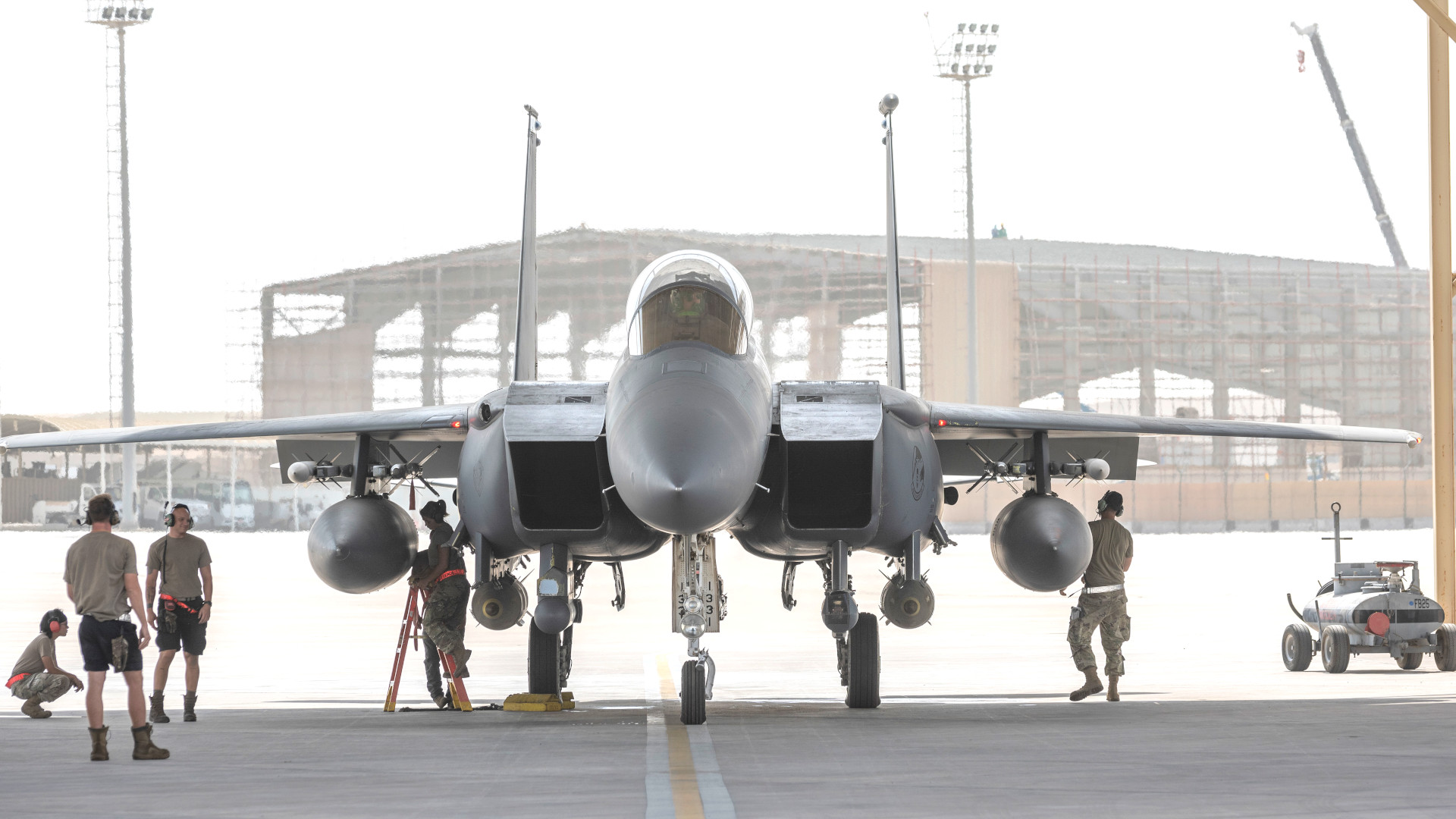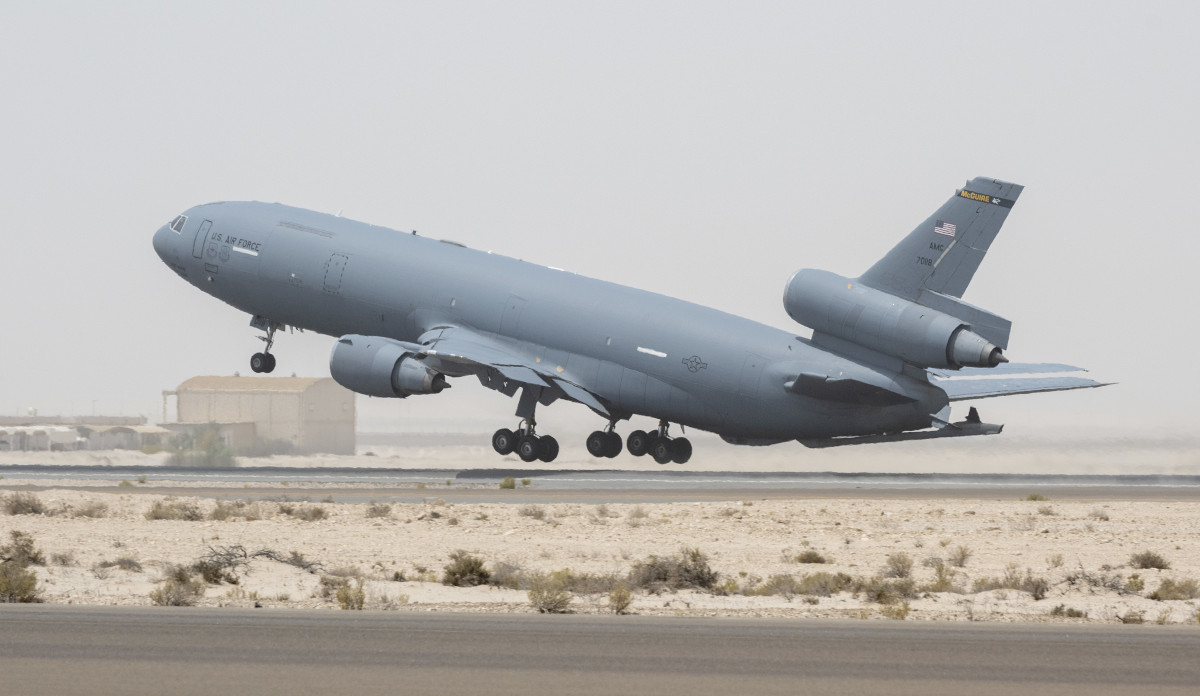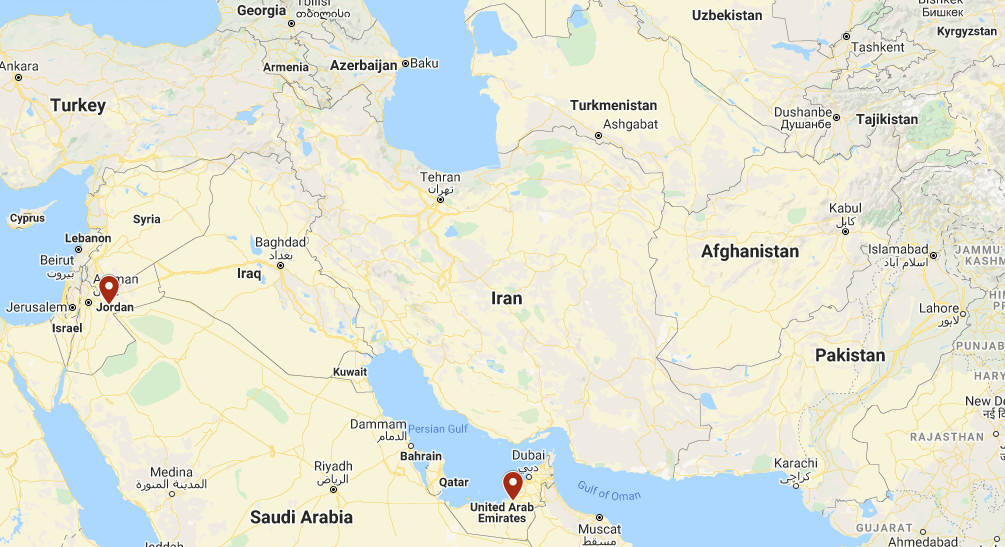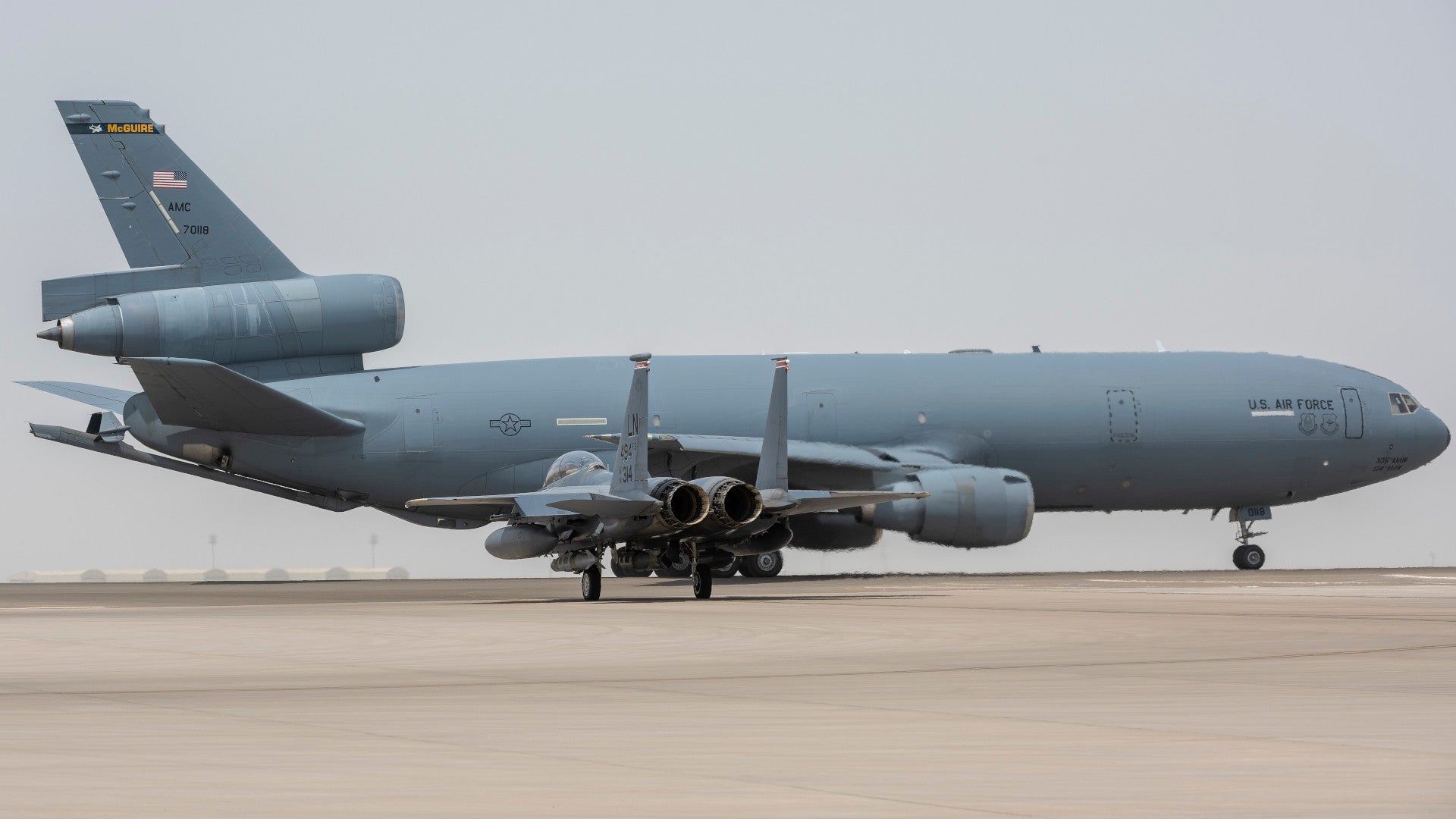As the Taliban continues to make significant gains against government security forces in Afghanistan, the U.S. military has indicated that it will continue to support the latter with airstrikes indefinitely, despite previously saying it would halt these operations by the end of August. However, the ongoing drawdown of American forces in the country, which has included completely vacating major air bases, has raised questions about how difficult it may be to provide robust and persistent airpower from “over the horizon.” Now, an official U.S. Air Force news item has offered specific details about the significant logistical hurdles to carrying out such strikes going forward.
In April, approximately half of the 494th Expeditionary Fighter Squadron, which flies F-15E Strike Eagles, deployed from an “undisclosed location” to Al Dhafra Air Base in the United Arab Emirates with the help of KC-10A Extender aerial refueling tankers from the 908th Expeditionary Air Refueling Squadron. The undisclosed location that the F-15Es deployed from is almost certainly Muwaffaq Salti Air Base in Jordan, which has hosted rotating contingents of Strike Eagles for years.

The purpose of this movement was to “support the Resolute Support mission set and improve the defensive posture in the Arabian Peninsula,” U.S. Air Force Captain Trey Pollard, an F-15E fighter weapons systems officer with the 494th said in a statement. Resolute Support is the official name of the NATO-led mission in Afghanistan. It also served to “highlight the 494th’s ability to project power forward into the AOR [area of responsibility] utilizing the Agile Combat Employment concept,” Pollard added.
This is hardly the first time that KC-10As, which have a significant, if often unappreciated secondary cargo-carrying capability, have been used to facilitate rapid movements of aircraft, as well as associated ground personnel and materiel, between bases in the Middle East. The Air Force has been working to make these kinds of missions, broadly, more routine as part of the Agile Combat Employment (ACE) concept. ACE is heavily focused on ways to increase flexibility and reduce predictability, with a particular eye toward helping to limit vulnerability to enemy attacks on established bases during operations.
“Without the KC-10 to help, they were hard pressed to make the trip all in one go,” Air Force Major Austin Bentley, an operations officer with the 908th, explained in a separate statement. “They would have had to load the cargo and passengers on another grey tail [another cargo aircraft] to get the equipment and maintainers and ground personnel back, and would need a KC-135, or even two, to get enough gas to the fighters to make the trip.”

Bentley’s comments underscore the general framing of the Air Force news item about this deployment of F-15Es to Al Dhafra, which lasted 66 days in total, as an example of the value the 908th’s KC-10As offer, specifically, and of the operational benefits that the ACE concept provides. The highlighting of the Extender’s capabilities is somewhat interesting given that the Air Force began retiring these aircraft, which first entered service in the 1980s, last year.
Beyond that, the details about the operations the 494th’s F-15Es carried out over Afghanistan with the support of those tankers show just how complicated it is to launch strikes in Afghanistan from other existing bases of operation in the region.
“We support dragging the fighters stationed at ADAB into country and remain with them as a dedicated tanker, or we fly into country and support specific tanker contracts with the F-15s from other bases to ensure they can accomplish their mission without divert,” Bentley explained. “Dragging” refers to tankers flying with contingents of other aircraft, typical combat jets, to a destination, refueling them at multiple points along the way.

The most direct route between Al Dhafra and Afghanistan that is available to American combat aircraft involves flying out over the Gulf of Oman and into the North Arabian Sea, before turning north, traveling first over Pakistan. It’s a round trip that’s easily over 2,000 miles long, regardless of where in Afghanistan the aircraft are actually headed.

All of this limits the amount of time aircraft can remain on station and creates the potential for lag between when a request for air support is received and when strikes actually occur, something that could be a matter of life and death during a firefight. It also limits the ability to respond to other kinds of time-sensitive tasking and negatively impacts the ability to provide any sort of persistent air support coverage across the entire country.
The overall distance increases the potential for serious fatigue, especially for the crews of single and two-seat combat jets. Those pilots and back-seaters are stuck in their ejection seats with, at best, limited options to even go to the bathroom, which can impact operational effectiveness. Flying these grueling missions on a regular basis also increases the strain on the aircraft themselves.
All of this is important to consider in the context of discussion not only whether or not the U.S. military will continue to provide air support to Afghan government security forces for the foreseeable future, but what any such air support will actually look like.
“I’m just not going to be able to comment about the future of U.S. airstrikes after Aug. 31,” U.S. Marine Corps General Frank McKenzie, the head of U.S. Central Command (CENTCOM), who is now also the top officer directly in charge of American operations in Afghanistan, told reporters at a press conference after meeting with Afghan President Ashraf Ghani in Kabul on July 25. “For the days and weeks ahead, we will continue with our airstrikes in support of our Afghan partners, and that’s all I’ll be able to give you.”
Just today, McKenzie said that the U.S. military had stepped up airstrikes in Afghanistan, but offered no new update on plans to continue those operations after Aug. 31. More than a dozen American strikes were carried out using manned and unmanned aircraft in the past week, according to the Associated Press. It’s worth noting that this is a very small number of strikes compared to peak periods of U.S. air activity over Afghanistan in the course of the past two decades or so of operations in the country.
Regardless, the realities that the 494th’s F-15Es faced when conducting operations over Afghanistan from Al Dhafra earlier this year may, at least in part, help explain why the majority of U.S. airstrikes in the country in the past month or so appear to have been carried out by unmanned aircraft. While it’s unclear where they have been flying from to conduct operations over Afghanistan, many drones, such as the MQ-9 Reaper, have the ability to remain on station for very long periods of time with operators on the ground, likely thousands of miles away, working in shifts. “Over the past 30 days, the U.S. military has launched about 10 airstrikes in Afghanistan, mostly with drones rather than fixed-wing aircraft,” according to a report from Task & Purpose that was published on July 24.
Of the sorties carried out by fixed-wing aircraft in that same time frame, it is likely that a significant number were conducted by B-52H bombers flying from the Persian Gulf region. As of May, there were six of these aircraft deployed to Al Udeid Air Base in Qatar. In the past week, video and pictures have emerged online purportedly showing B-52Hs flying low enough over Kabul and Kandahar to be plainly visible, potentially with the hope of also having a deterrent effect.
B-52Hs, which have much greater range and payload capacity than combat jets like the F-15E, have been employed over Afghanistan on many occasions over the past two decades, generally flying in from the Persian Gulf. They’ve even made marathon flights to the skies over the country from the island of Diego Garcia more than 2,500 miles away in the Indian Ocean B-1Bs were also heavily employed in the past for the same reasons. Both of these bombers can also loiter over a portion of the battlefield for longer periods than smaller jets, but they still have to make the same lengthy trek to and from forward bases before and after missions.
There has been discussion about U.S. military forces potentially operating from bases in neighboring countries after the completion of the withdrawal from Afghanistan, which could allow aircraft to be positioned closer to the ongoing fighting. However, Pakistani officials have publicly stated that they have no intention of hosting American troops, and countries in Central Asia, so far, seem disinclined to assist, as well. Earlier this month, Russia, which has significant influence in that region, publicly warned against the deployment of U.S. military personnel to Kazakhstan, Kyrgyzstan, and Tajikistan. A more recent unconfirmed Russian media report has suggested the Kremlin might have quietly changed its position amid growing concerns about the security situation in Afghanistan.
In addition, despite laudatory statements about the abilities of Afghan government security forces, there are significant concerns about the ability of the Afghan Air Force to help fill any resulting gap in close air support and strike capacity after Aug. 31. Last week, a group of Afghan lawmakers said that a third of all of the aircraft in the country’s air arm was non-flyable and that it had completely run out of laser-guided 70mm Advanced Precision Kill Weapon System II (APKWS II) rockets, a very capable low-cost precision-guided munition. A lack of precision-guided munitions available to the Afghan Air Force could be one of many factors contributing to a significant rise in reported civilian casualties in Afghanistan.
After two decades of American and other foreign assistance, the Afghan Air Force remains heavily reliant on foreign contractors for maintenance and logistics, as well as training support. The departure of a significant number of those contractors has reportedly led to at least some maintenance training being conducted remotely, via Zoom calls.
On top of that, the Taliban have been actively pursuing a campaign of assassinating Afghan pilots with a clear goal of hampering the government’s ability to conduct air operations of any kind. All of this has prompted questions about whether the Afghan Air Force has sufficient pilots and other personnel to operate and maintain what aircraft it has that are flyable, especially as new planes and helicopters are being delivered. “We have the pilots, the maintainers, but we … need the support, continuous support to continue the mission,” an Afghan official told Reuters earlier this month.
There’s also the matter of coordination between American forces flying in from outside the country and Afghan forces on the ground, who won’t have embedded U.S. advisors or otherwise be paired up with U.S. troops. Efforts have been made over the years to try to train more Afghan troops on the ground to be better able to direct airstrikes. Conducting strikes without being able to closely communicate with Afghan personnel down below could be dangerous, if not deadly to both those forces or innocent bystanders. It will also lead to less effective implementation of close air support.
Airstrikes were key to the ousting of the Taliban from power following the initial U.S.-led intervention in the country in 2001 in the wake of the 9/11 terrorist attacks. American warplanes subsequently became essential to keeping that group at bay. The U.S. military had until very recently continued to meet the vast majority of aerial combat capacity demands, as well as provide the ability to project that power on a persistent basis across the entire country, day or night.
As such, all of this can only raise additional concerns about the future of Afghanistan’s central government. “A significant amount of territory has been seized over the course of six, eight, 10 months by the Taliban, so momentum appears to be — strategic momentum appears to be — sort of with the Taliban,” U.S. Army General Mark Milley, the Chairman of the Joint Chiefs of Staff, told reporters last week, though he pushed back at the idea that a Taliban takeover of Kabul was inevitable.
American airstrikes, or the lack thereof, are likely to be an important factor in whether the Taliban can maintain that momentum going forward. Having to carry out those missions from very far “over the horizon” will only further affect the impact that they will have on this new stage of the conflict in Afghanistan.
Contact the author: joe@thedrive.com
